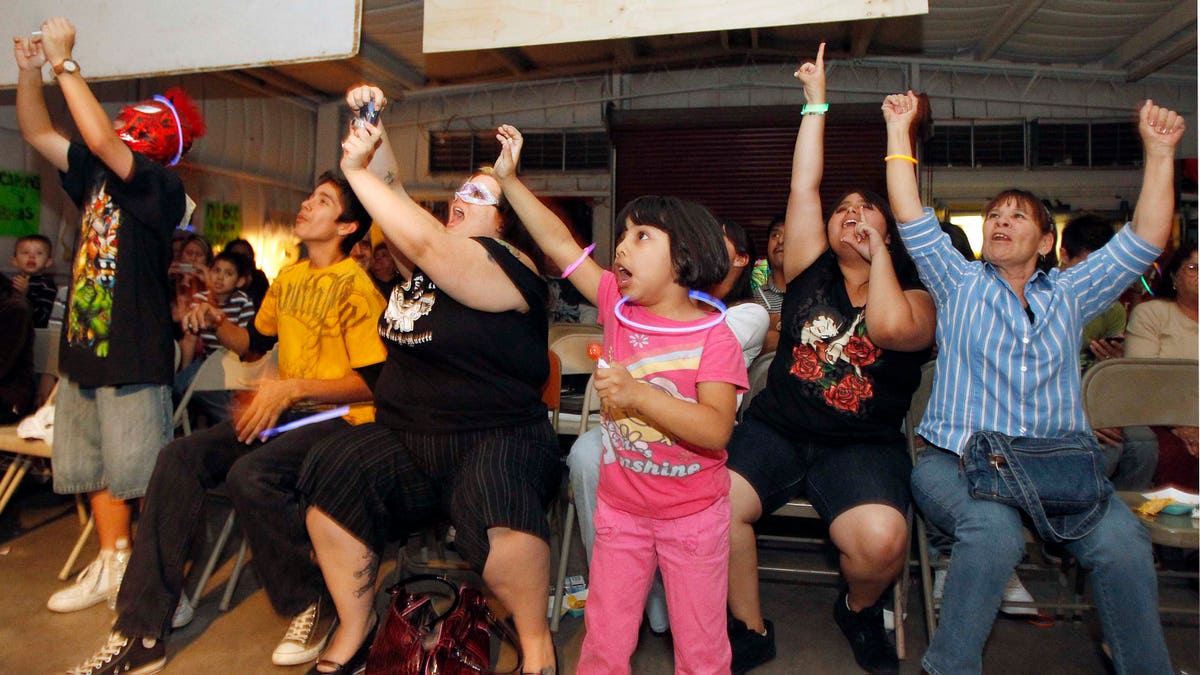
This Friday, April 30, 2010 photo shows fans as they cheer during a match at a Lucha Libre Mexican wrestling night, part of Lucha Libre Internacional Gladiadores Unidos, at a family friendly venue in Phoenix. (AP Photo/Ross D. Franklin)
The wrestler turned to the audience. They screamed and cheered at Yuki, who wore a pink and black spandex.
He threw candy at them, as kids scrambled to grab some. Then they went back to the family activity that is increasingly popular – swearing, yelling and body-slamming at “lucha libre” wrestling matches.
In heavily Hispanic cities such as Phoenix, some parents are choosing the decades-old Mexican form of free fighting as a way to gain some quality time.
Little kids can swear and flash the middle finger during what are sometimes violent matches. Mothers typically have one eye on a fight and the other on a stroller.
"When you're at a movie, it's quiet and relaxed. Here you can yell, scream and get all the anger out of you. You can have fun and all that," said Ernesto del Real, who has taken his wife and three of his children, ages 5-11, to body-slamming bouts on Friday nights.
The profanity and pummeling might appall non-Hispanic families. But anyone familiar with lucha libre would know it's part of the spectacle.
"When you're at lucha libre, you shout obscenities, insult people, act in ways that wouldn't necessarily be acceptable elsewhere," said Heather Levi, an assistant professor in anthropology at Temple University. "I remember the time I was sitting in front of woman who was teaching a 3-year-old to do it. It was like 'OK now you say...'"
Tonight's match is staged by one of a few lucha libre operations in metropolitan Phoenix. The setup is minimal: a ring and rows of metal folding chairs. Everything is housed in an industrial building in a lower class neighborhood dotted with fenced off businesses and run-down apartment buildings.
Inside, alcohol and smoking are banned.
Licha Vasquez, who works as a nanny but was a manager for matches up until recently, said the activity is a cheap form of entertainment and it's important "for a family to have fun, to be able to bring their kids, to know they're not going to drink."
Lucha libre has been rooted in Mexican popular culture since the 1930s. Wrestlers wear colorful masks and personas. The genre gained more notice when it was showcased on TV and in B movies.
"Children were not allowed into arenas (in Mexico City) until the mid-1980s," said Levi, author of "The World of Lucha Libre: Secrets, Revelations, and Mexican National Identity."
Now, she said, "In Mexico, people bring their children, their grandparents."
In the Southwest, it seems that people are seeing lucha libra as a cultural thing, "really embracing it as something Mexican they take their kids to," said Levi. For some kids who have grown up in the U.S., watching Jack Black in "Nacho Libre," has been the extent of their lucha libre exposure. Seeing authentic luchadores go at it has been a bonding experience.
Johana Lamadrid, 18, an Arizona State University student, didn't think she was going to like it when her family first went to a match.
"Usually I'm very quiet especially if I'm in front of my family, I usually don't yell or anything," Lamadrid said. "When I'm there, me and my mom are like one and we're just like yelling and everything."
Now her family goes every week. Her mom, Cristina, isn't worried that watching lucha libre will lead her other daughters, ages 7 and 12, to become ill-mannered hellions.
"It's like a game. They don't take it seriously. It's part of the show," Cristina Lamadrid said in Spanish.
Cristina Lamadrid said she's never had a problem with her kids cursing or acting out in school. Even at lucha libre, they will sometimes ask for permission before gesturing or swearing. The matches even come in handy as leverage for good behavior.
"When the week starts, about Wednesday, they start asking, making sure they're going to get to go," Cristina said. "(My daughter) knows if she don't clean the room, she cannot go. And it's clean."
Based on reporting by The Associated Press.
Follow us on twitter.com/foxnewslatino
Like us at facebook.com/foxnewslatino
